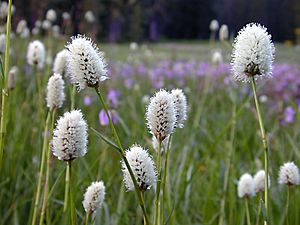American bistort facts for kids
Quick facts for kids American bistort |
|
|---|---|
 |
|
| Scientific classification | |
| Genus: |
Bistorta
|
| Species: |
bistortoides
|
| Synonyms | |
|
|
The Bistorta bistortoides is a wild plant often called American bistort or western bistort. Other names include smokeweed, mountain meadow knotweed, mountain buckwheat, or mountain meadow buckwheat. It is a perennial herb, meaning it lives for more than two years. This plant belongs to the buckwheat and knotweed family, known as Polygonaceae. Scientists are still working to fully agree on its exact species name.
Contents
Where American Bistort Grows
This plant is found across the western parts of North America. You can see it from Alaska and British Columbia in the north. It grows south into California and east into the Rocky Mountains.
Its Habitat
American bistort grows in many different places. It can be found from the lower hills to high up above the timberline. The timberline is the elevation where trees stop growing because it's too cold or windy.
Size and Appearance
Plants growing very high up, above 7,500 feet (about 2,250 meters), are usually smaller. They often grow to less than 12 inches (30 centimeters) tall. In other areas, these plants can reach over 1.5 feet (20–60 centimeters) in height.
The leaves of the American bistort are thick and leathery. They can be up to 40 centimeters (about 1.3 feet) long. Most of these leaves grow from the base of the stem.
The plant has a dense, cylinder-shaped or oval-shaped cluster of flowers. This cluster is called an inflorescence. It is packed with many small flowers, which are white to pinkish in color. Each flower is only a few millimeters wide. They have stamens that stick out, which are the parts that produce pollen.
Who Eats American Bistort
Several animals enjoy eating the American bistort. Rodents and bears often dig up and eat the roots. Larger animals like elk and deer browse on the plant's leaves.
How Native Americans Used This Plant
American bistort was a very important food source for Native American peoples. Those living in the Mountain West, such as the Blackfoot and Cheyenne peoples, used it widely.
Edible Parts
- Roots: The roots of the plant are edible. They can be eaten raw or cooked by roasting them over a fire. Their taste is similar to chestnuts.
- Seeds: The seeds can be dried and then ground into flour. This flour was used to make bread. People also roasted the seeds and ate them as a cracked grain.
- Young Leaves: The young leaves of the plant can be eaten too. They can be consumed raw or cooked.

